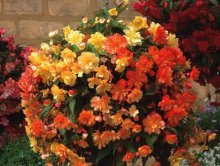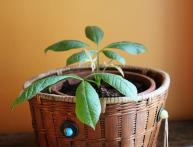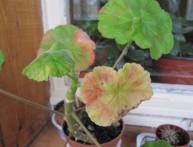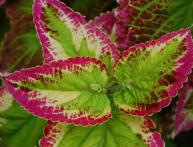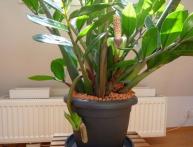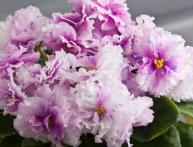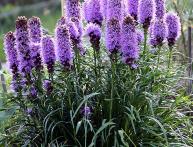Ampelous begonia, growing from seeds for baskets and flowerpots

Begonia came to indoor and garden floriculture from the wild nature of South America, Asia, India, and Africa. The world first learned about the plant at the end of the 17th century, when the botanist C. Plumier, during an expedition to the islands near South America, found and described several plant species that had not previously been encountered. The scientist named the new species Begonia, in honor of the organizer of the scientific expedition M. Begon.
Subsequently, more than 1,000 species of begonias have been found in the wild. The basis for indoor and garden varieties and hybrids is approximately 130 species of these plants. Many varieties of both flowering and leaf forms have been obtained.
For lovers of bright and unpretentious plants, with double and semi-double flowers, beautiful, asymmetrical foliage, the ampelous form of begonias receives special attention.
Thanks to its decorative appearance, lush flowering and ease of care, even a novice gardener can grow it.
Plants of this genus are propagated mainly by tubers and cuttings, but there are situations when, in order to obtain ampelous begonia, growing from seeds is the only possible way to obtain plants with the desired flowers and leaves in sufficient quantities.
Content:
Preparing the soil for sowing
In order to grow healthy seedlings of hanging begonias from seeds, you must first take care of the composition of the soil.To sow begonia seeds, you need soil with a slightly acidic, close to neutral, reaction. To prepare the right mixture, you need:
- sand
- leaf soil
- turf land
Since the seeds of ampelous begonia are very small and can easily suffer from mold, all ingredients should be washed and heated in the oven for twenty to thirty minutes.
After that, mix everything in the proportion of one part sand, four parts leaf soil and one turf. Since the optimal time for sowing seedlings is the end of December - January, you need to take care of the soil before the onset of frost.
You can also use ready-made soil for begonias.
Sowing seeds
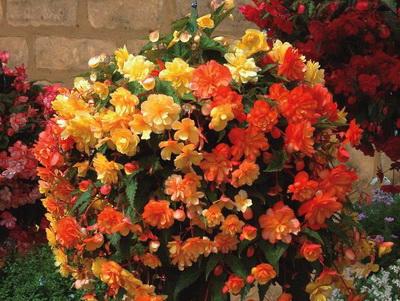
The extremely small size of ampelous begonia seeds (about 60 thousand seeds in one gram) makes it difficult to sow it evenly. Therefore, before planting, the soil in the planting boxes must be well moistened and this should preferably be done a day before sowing. And before filling the containers with soil, do not forget to add drainage to the bottom.
Distribute the seeds for sowing evenly over the surface and cover with film or glass to maintain moisture; do not water after sowing, as water can pull the seeds under the layer of soil and you may not wait for seedlings.
It's more convenient to use granular version of seeds ampelous begonia. It should be taken into account that they need to be taken 1.5 - 2 times more than the expected number of plants at the output. For example, if you need five seedlings, then you need to sow 10 granules; if 100, then 200 granules.
It is better to plant granulated seeds in a cassette-type container, place two granules in each cell and lightly press them into the soil to speed up the dissolution of the covering shell, then cover with a cover glass.
For faster emergence of seedlings in the room where the seedling box is located, it is necessary to maintain a temperature of + 24 + 25 degrees. Seed germination time is from 8 - 9 days to 21-25 days.
Caring for hanging begonia seedlings
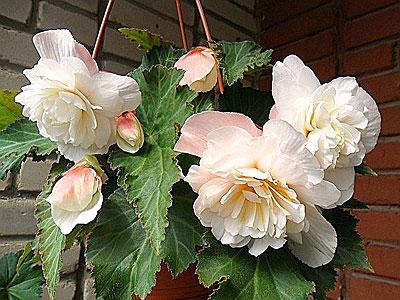
During the period when the first shoots appear, it is worth protecting the seedlings from direct sunlight and drying out of the soil. Since the shoots are very tender at this time, it is better to use bottom watering by placing the container in a tray with water. At the same time, you can reduce the room temperature to +20 +21 degrees.
If the seedlings have sprouted in January, then the shoots of ampelous begonia will greatly lack natural light and the sprouts will be weak and thin, most of them will die, because in January the days are still very short, so you need to take care of an artificial light source in advance. It is advisable that the seedlings remain under continuous lighting for at least 12-14 hours.
Additional lighting will have to be left on until two o'clock in the morning. As the seedlings grow and daylight hours increase, this period will gradually shorten.
Picking, growth stimulation
After about 50 - 60 days, the grown seedlings need picking. If the seedlings are intended for sale, then it is more convenient to plant them in separate cups or pots, the soil is taken as for sowing, drainage is poured onto the bottom and the cup is filled with earth so that about 0.8 - 1 cm remains to the edge. The height of the cup is at least 10 cm. To decorate hanging baskets, 3 to 5 plants are picked at once into a flat wide pot.
Cups with picked seedlings it is necessary to install so that all plants receive good lighting and periodically they must be rotated or rearranged.At the same time, you can lower the temperature by another one or two degrees.
The stems of ampelous begonia tend to stretch naturally, so you should not use growth stimulants, but 12 - 14 days after picking, young plants need to be fed with complex fertilizers. The frequency of further feeding is once every two weeks. At the beginning of the growing season, it is better to apply nitrogen fertilizers, and during the period of buds and flowering - phosphorus-potassium fertilizers.
The growth of seedlings until they reach a size suitable for planting in the ground, on balconies and loggias, lasts approximately 20 to 22 weeks. Thus, if the seedlings sprouted in January, at the end of May - beginning of June the plants are fully formed and ready to flower.
Ampelous begonias grown from seeds are planted in baskets and hanging pots. They are posted on:
- balconies
- loggias
- verandas
- terraces
The first numerous flowers open on beautifully flowing stems already at the beginning of summer, flowering lasts for a long time, until the onset of frost, and if you bring it indoors, ampelous begonia grown from seeds will continue to bloom for some time.
It is noteworthy that begonias have two types of flowers: small female flowers and elegant, large male ones. If poorly cared for, begonia can shed its male flowers and lose its decorative properties, so when growing a flower, you must follow basic agricultural techniques.
Secrets of rooting ampelous begonia on video:
Interesting information about the vegetable garden

